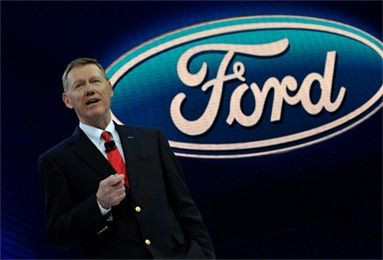
Not able to sell a product is bad news. Growing demand for a product is great news, but it can still be quite a problem nonetheless.
Earlier this week, Edmunds.com projected that sales may reach nearly 1.4 million units by the end of May and are expected to continue on climbing until it reaches nearly 14.4 million by the end of the year. Analysts await for the official May numbers to be announced tomorrow, confident that the final figure should reveal a whopping 30 percent increase over May 2011 performance.
Given the spike, according to Detroit News, Ford Motor Co. President and CEO Alan Mulally admitted yesterday that the American automaker is struggling to build enough vehicles to meet its demand.
While the Ford plant is adding shifts and tweaking work schedules to optimize production and to meet the demand in North America, Mulally said that supplier shortage are among the challenges, in the short run, that hinders Ford's ability to produce as many cars and trucks as it wants.
"We're going to increase production through the rest of the year," said the Ford CEO. "We have limits on our production as we're going up, because as we restructure the entire business, we're bringing along the entire supply chain, so we really can't make as many vehicles as people want right now."
Mulally continued, "Within the next two quarters, we'll be adding all the third shifts and the extra production so by the end of the year, we'll be able to produce the amount of vehicles that people want. But we'll take a hit in the near term - just because we're limited in production."
Ford vehicles currently with critical inventories include hot sellers Focus, Fusion and Explorer. Given the hiccup, Ford's first quarter US market share has now fallen to 15.2 percent from 16 percent last year. Before this quarter, Ford had steadily gained market share for three straight years.
While Mulally is confident that Ford has room to grow in North America, he has elected not to bring additional plants online. In the meantime, a third shift will be added to the Focus facility at Wayne, MI, another third shift for Chicago's Taurus, SHO, Lincoln MKS, and Interceptor plant, a second shift for the F-150 plant in Kansas city, and finally a third shift at Louisville for the new Ford Escape.
IHS Automotive analyst Rebecca Lindland shared her thoughts on Ford's current market share, raising points on both production as well as competition. In the past decade, automakers have closed dozens of plants, forcing the few remaining to operate at close to 100 percent capacity. Fearing the possibility of a sharp decline in auto sales following a bubble pop, many of the factories are hesitant to boost capacity again despite automaker demands. Lindland says, "The industry is so pared down; there was such a dramatic drop-off and (suppliers) are terrified of retooling for 15 (million) or 16 million (sales a year)," Lindland said.
What's more, competition for market share between automakers are intensifying. Imports Toyota and Honda experienced massive gains of 90 percent and 50 percent since last year's devastating earthquake. Of the 'Big 3,' Chrysler experienced a 42 percent rise in May sales while GM and Ford received respectable 11 percent and 16 percent gains, respectively. Lindland states the obvious: "The amount of competition Ford is facing, like everybody, is incredible,"




